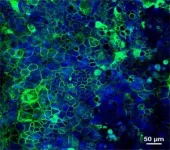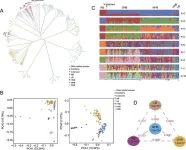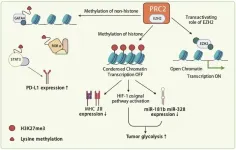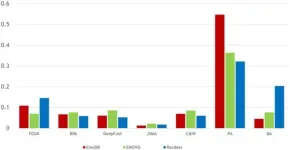A pivotal study has discovered a protein phosphorylation mechanism that plays a critical role in the negative regulation of flavonoid biosynthesis in tea plants (Camellia sinensis) during drought stress. This insight into the molecular response of tea plants to environmental stress could lead to the development of agricultural strategies to enhance crop resilience and quality preservation under water scarcity conditions.
Drought stress poses a significant challenge to agriculture, causing substantial yield losses in many crops. Tea plants, known for their rich flavonoid content which enhances both quality and health benefits, are particularly affected. Under drought conditions, the production of these valuable compounds declines, impacting the overall quality of tea. Addressing these issues requires a deeper understanding of the molecular mechanisms that regulate flavonoid biosynthesis during drought stress. Due to these problems, it is essential to undertake detailed research to uncover strategies that can mitigate the negative effects of drought on tea plants.
Researchers from Anhui Agricultural University have published a study (DOI: 10.1093/hr/uhae136) on May 5, 2024, in the journal Horticulture Research. The study investigates the phosphorylation of a WD40-repeat protein (CsWD40) and its role in regulating flavonoid biosynthesis in tea plants under drought stress. The findings provide new insights into the molecular responses of tea plants to environmental stress.
The study reveals that drought stress increases the expression of CsMPK4a, a mitogen-activated protein kinase, in tea leaves. CsMPK4a interacts with the WD40-repeat protein CsWD40, phosphorylating it at specific sites (Ser-216, Thr-221, and Ser-253). This phosphorylation disrupts CsWD40's interaction with key transcription factors responsible for flavonoid biosynthesis, leading to reduced flavonoid production. Experiments introducing dephosphorylated (CsWD403A) and phosphorylated (CsWD403D) variants of CsWD40 into Arabidopsis plants further confirmed this regulatory mechanism. Dephosphorylated CsWD40 enhanced flavonoid production, while phosphorylated CsWD40 significantly decreased it. Additionally, transient overexpression of these variants in tea leaves under stress conditions mirrored these results, indicating the phosphorylation state of CsWD40 plays a crucial role in modulating flavonoid biosynthesis. This detailed analysis provides new insights into how tea plants respond to drought at the molecular level, highlighting potential targets for improving stress tolerance.
Dr. Liping Gao, one of the corresponding authors, stated, "Our findings uncover a critical regulatory mechanism that affects flavonoid biosynthesis in tea plants under drought stress. Understanding this pathway opens up new possibilities for breeding drought-resistant tea varieties with optimized flavonoid content."
The discovery of the phosphorylation sites on CsWD40 provides potential targets for gene editing to develop tea cultivars with enhanced drought tolerance and stable flavonoid production. This research not only contributes to the fundamental understanding of stress responses in tea plants but also offers practical applications in improving tea quality and resilience to environmental stressors.
###
References
DOI
10.1093/hr/uhae136
Original Source URL
https://doi.org/10.1093/hr/uhae136
Funding information
This work was financially supported by Anhui Provincial Natural Science Foundation (2308085MC94, 202204c06020035), the joint funds of National Natural Science Foundation of China (U21A20232), and the Natural Science Foundation of China (32000366, 32372756), the National Key Research and Development Program of China (2022YFF1003103).
About Horticulture Research
Horticulture Research is an open access journal of Nanjing Agricultural University and ranked number one in the Horticulture category of the Journal Citation Reports ™ from Clarivate, 2023. The journal is committed to publishing original research articles, reviews, perspectives, comments, correspondence articles and letters to the editor related to all major horticultural plants and disciplines, including biotechnology, breeding, cellular and molecular biology, evolution, genetics, inter-species interactions, physiology, and the origination and domestication of crops.
END
The molecular shield: how tea plants combat drought through protein phosphorylation
2024-08-09
(Press-News.org)
ELSE PRESS RELEASES FROM THIS DATE:
Spectral measurements capable of estimating nutrient content of forest tree leaves
2024-08-09
The general health of forests can be estimated by the micro- and macronutrient content of tree leaves to help inform forest management decisions in the light of climate change, species loss and other variables. Traditional methods of assessing nutrient levels in forests are expensive and labor-intensive. Researchers recently analyzed the reflected spectra from tree foliage to accurately estimate the nutrients of leaves, offering a faster, larger-scale method of assessing forest health.
Field methods of collecting leaf samples ...
Blueprint for blueberry improvement: genetic and epigenetic discoveries
2024-08-09
Recent research has uncovered significant genetic and epigenetic variations in blueberry cultivars, particularly between northern highbush (NHB) and southern highbush (SHB) blueberries. The study highlights gene introgression's role in SHB's adaptation to subtropical climates and identifies key genes, such as VcTBL44, associated with fruit firmness. These findings offer valuable insights and resources for future blueberry breeding.
Blueberries, part of the Vaccinium genus, are renowned for their nutritional benefits and increasing global demand. However, cultivation faces challenges like ...
The heightened importance of EZH2 in cancer immunotherapy
2024-08-09
Enhancer of zeste homolog 2 (EZH2) is a catalytic subunit of the Polycomb-repressive complex 2 (PRC2), which plays a crucial role in transcriptional repression through the methylation of histone H3 on lysine 27 (H3K27me3). This epigenetic modification leads to chromatin compaction and gene silencing. EZH2 is frequently overexpressed in a variety of cancers, including head and neck, breast, prostate, bladder, colorectal, lung, pancreatic, melanoma, and lymphoma. Mutations in the EZH2 gene are also prevalent in several hematological malignancies, such as B-lymphomas and follicular lymphomas. The dual role of EZH2 as both a tumor suppressor and oncogene depending on the cancer type ...
Researchers expose vulnerability of speech emotion recognition models to adversarial attacks
2024-08-09
Recent advancements in speech emotion recognition have highlighted the significant potential of deep learning technologies across various applications. However, these deep learning models are susceptible to adversarial attacks. A team of researchers at the University of Milan systematically evaluated the impact of white-box and black-box attacks on different languages and genders within speech emotion recognition. The research was published May 27 in Intelligent Computing, a Science Partner Journal.
The ...
Classical music lifts our mood by synchronizing our “extended amygdala”
2024-08-09
Whether Bach, Beethoven, or Mozart, it’s widely recognized that classical music can affect a person’s mood. In a study published August 9 in the Cell Press journal Cell Reports, scientists in China use brainwave measurements and neural imaging techniques to show how Western classical music elicits its positive effects on the brain. Their goal is to find more effective ways to use music to activate the brain in those who otherwise don’t respond, such as people with treatment-resistant depression.
“Our research integrates the fields of neuroscience, psychiatry, and ...
New technology uses light to engrave erasable 3D images
2024-08-09
Imagine if physicians could capture three-dimensional projections of medical scans, suspending them inside an acrylic cube to create a hand-held reproduction of a patient's heart, brain, kidneys, or other organs. Then, when the visit is done, a quick blast of heat erases the projection and the cube is ready for the next scan.
A new report in the journal Chem by researchers at Dartmouth and Southern Methodist University (SMU) outlines a technical breakthrough that could enable such scenarios, and others with widespread utility.
The study introduces a technique that uses a specialized ...
How did mental health parity laws affect new moms?
2024-08-09
Pregnant and postpartum women with depression and anxiety have a slightly better chance of getting psychotherapy these days, a new study finds. And they are paying less of their own money when they do.
The changes in care and cost happened mainly after the Affordable Care Act took effect in 2014, and to a lesser extent after the Mental Health Parity and Addiction Equity Act, or MHPAEA, took effect in 2010, the analysis shows.
Both laws aimed at reducing insurance-related barriers to mental health care.
Even so, only about 10% of women with private insurance ...
Universal free school meals and school and student outcomes
2024-08-09
About The Study: In this systematic review, universal free school meals were associated with increased meal participation, no or slight improvements in attendance, and decreased obesity prevalence and suspension rates; certainty of evidence was moderate for lunch participation and low or very low for other outcomes. Studies did not report several important outcomes, such as diet quality and food security, suggesting the need for more high-quality research encompassing policy-relevant indicators.
Corresponding Author: To ...
Researchers crack a key celiac mystery
2024-08-09
People with celiac disease must navigate everyday life by avoiding gluten, a protein in wheat, rye and barley which can trigger painful symptoms in the gut, impede the absorption of nutrients and raise the risk of other serious long-term issues.
The autoimmune disorder affects about 1 per cent of the population. Its rate of occurrence has roughly doubled in the past 25 years, but there is no treatment available.
An interdisciplinary team of medical and engineering researchers centred at Canada’s McMaster University and including colleagues from the US, Australia, and Argentina, has spent the ...
Continuing climate warming trend and pronounced interannual variability in precipitation in the Three Gorges Region in 2022–2023
2024-08-09
The Three Gorges Region of the Yangtze River (TGR) in China has a unique geographical location, complex geomorphological features, and a fragile and sensitive climate. The Three Gorges Project, as a large-scale comprehensive water conservancy hub project in the region, has not only greatly changed the nature, society and economy of the area, but also brought great benefits and created problems, such as environmental and climatic impacts. Therefore, it is of great importance to conduct climate and environmental monitoring in the region.
Recently, a team led by Chen Xianyan, a Professor at ...









